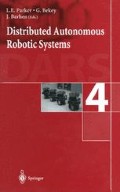Abstract
This paper presents an experiment in collective robotics in which a group of autonomous robots searches for an infrared target beacon placed in a corner of the exploration area. This task is a more experimentally tractable version of the plume tracing problem, in which robots search for the source of an odor plume. Two different exploration strategies (collaborative and non-collaborative) are implemented and compared on the basis of several team performance metrics. The collaborative strategy uses a simple, binary signaling schema among robots. The experiment is implemented at three different levels: in a physical setup composed of groups of 1 to 8 Moorebot robots, in Webots, a 3D sensor-based, kinematic simulator, and with probabilistic simulations. Results show that the collaborative approach drastically improves the search across several metrics. Furthermore, the probabilistic model qualitatively and quantitatively reproduces the enhanced team performance via collaboration. Additional investigations using the probabilistic model indicate that the optimal number of robots is a function of the ratio between target and exploration areas.
Access this chapter
Tax calculation will be finalised at checkout
Purchases are for personal use only
Preview
Unable to display preview. Download preview PDF.
References
E. Bonabeau, M. Dorigo, and G. Theraulaz. Swarm Intelligence: From Natural to Artificial Systems. Oxford University Press, New York, US, 1999.
R. Beckers, O.E. Holland, and J.L. Deneubourg. From local actions to global tasks: Stigmergy and collective robotics. In R. Brooks and P. Maes, editors, Proc. of the Fourth Workshop on Artificial Life ,pages 181–189, Boston, MA, 1994. MIT Press.
A. Martinoli, A. J. Ijspeert, and F. Mondada. Understanding collective aggregation mechanisms: From probabilistic modelling to experiments with real robots. Robotic and Autonomous Systems ,29:51–63, 1999.
O.E. Holland and C. Melhuish. Stigmergy, self-organization, and sorting in collective robotics. Artificial Life ,5:173–202, 1999.
A. Billard, A. J. Ijspeert, and A. Martinoli. A multi-robot system for adaptive exploration of a fast changing environment: Probabilistic modelling and experimental study. Connection Science ,11:359–379, 1999.
A. Martinoli and F. Mondada. Collective and cooperative group behaviours: Biologically inspired experiments in robotics. In O. Khatib and J. K. Salisbury, editors, Proc. of the Fourth International Symposium on Experimental Robotics ISER-95 ,pages 3–10, Stanford, U.S.A., June 1995. Springer Verlag.
M. J. B. Krieger and J.-B. Billeter. The call of duty: Self-organised task allocation in a population of up to twelve mobile robots. Robotics and Autonomous Systems ,30:65–84, 2000.
C. R. Kube and E. Bonabeau. Cooperative transport by ants and robots. Robotics and Autonomous Systems ,30:85–101, 2000.
O. Michel. Webots: Symbiosis between virtual and real mobile robots. In Proceedings of the First International Conference on Virtual Worlds, VW’98 ,pages 254–263, Paris, France, July 1998. Springer Verlag.
F. Mondada, E. Franzi, and P. Ienne. Mobile robot miniaturization: A tool for investigation in control algorithms. In T. Yoshikawa and F. Miyazaki, editors, Proc. of the Third International Symposium on Experimental Robotics ISER-93 ,pages 501–513, Kyoto, Japan, 1993. Springer Verlag.
A.F.T. Winfield and O.E. Holland. The application of wireless local area network technology to the control of mobile robots. Microprocessors and Microsystems ,23:597–607, 2000.
Author information
Authors and Affiliations
Editor information
Editors and Affiliations
Rights and permissions
Copyright information
© 2000 Springer-Verlag Tokyo
About this chapter
Cite this chapter
Hayes, A.T., Martinoli, A., Goodman, R.M. (2000). Comparing Distributed Exploration Strategies with Simulated and Real Autonomous Robots. In: Parker, L.E., Bekey, G., Barhen, J. (eds) Distributed Autonomous Robotic Systems 4. Springer, Tokyo. https://doi.org/10.1007/978-4-431-67919-6_25
Download citation
DOI: https://doi.org/10.1007/978-4-431-67919-6_25
Publisher Name: Springer, Tokyo
Print ISBN: 978-4-431-67991-2
Online ISBN: 978-4-431-67919-6
eBook Packages: Springer Book Archive

